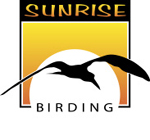
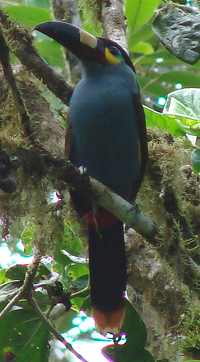 Galápagos
Galápagos
& Ecuador
September 25 - October 9, 2008
2007 Trip Reports and Photos>>
This extended tour offers birding
in the Andes
as well as a full
Galápagos tour!
For more information, contact Gina Nichol at [email protected]
This tour begins with a stay at an exquisite cloud forest lodge in mainland Ecuador. Here in the heart of the mid-elevation Andes, you'll have the chance to explore the extensive trails and encounter a wealth of tropical bird species. The gardens of our lodge can easily produce 50 species in a morning and by travelling a little further we can search for specialities of the Andes. We'll spend time watching the gorgeous hummingbirds that visit the feeders set out in the lodge’s lush grounds and marvel at exotic, colorful birds at every turn. The highlight will be a visit to the lek of the truly spectacular Andean Cock-of-the-Rock and at least three species of tame antpitta.
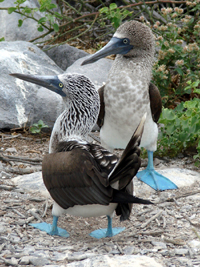 From here we move on to the Galápagos Islands, the “enchanted isles” made famous by Charles Darwin. These magical islands are the number one destination for most wildlife enthusiasts. We'll travel between the islands on a first class motor yacht built specifically to cruise the Galápagos Islands. We'll visit all the most important islands and have countless opportunities to look at the most unique wildlife imaginable - from the 26 endemic bird species to spectacular seabird colonies, Marine Iguanas, Flightless Cormorants, Blue-footed, Red-footed, and Nazca Boobies, Giant Tortoises, Penguins, Darwin’s Finches, and many more. This will prove to be an unforgettable life experience! If you’ve ever wanted to visit the Galápagos Islands and experience their unique magic, this tour will live up to all your expectations.
Our itinerary is designed to see as many Galápagos endemics and as much wildlife as possible. We will be accompanied by top Ecuadorian guide
Juan Carlos Calvachi throughout the trip and
a Galápagos National Park guide during our cruise.
From here we move on to the Galápagos Islands, the “enchanted isles” made famous by Charles Darwin. These magical islands are the number one destination for most wildlife enthusiasts. We'll travel between the islands on a first class motor yacht built specifically to cruise the Galápagos Islands. We'll visit all the most important islands and have countless opportunities to look at the most unique wildlife imaginable - from the 26 endemic bird species to spectacular seabird colonies, Marine Iguanas, Flightless Cormorants, Blue-footed, Red-footed, and Nazca Boobies, Giant Tortoises, Penguins, Darwin’s Finches, and many more. This will prove to be an unforgettable life experience! If you’ve ever wanted to visit the Galápagos Islands and experience their unique magic, this tour will live up to all your expectations.
Our itinerary is designed to see as many Galápagos endemics and as much wildlife as possible. We will be accompanied by top Ecuadorian guide
Juan Carlos Calvachi throughout the trip and
a Galápagos National Park guide during our cruise.
Itinerary:
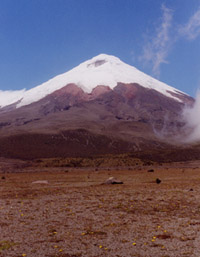 Day 1 - Arrival Quito
Day 1 - Arrival Quito
Plan to arrive in Quito by evening. After clearing customs, we will be transferred to our private guest house, El Jardin del Colibri, for the evening. El Jardin di Colibri offers charming B&B accommodations for birders complete with hummingbird feeders and 2-acres of land. Its location just 25 minutes east of downtown Quito provides a convenient location from which to begin the mainland portion of our trip.
Days 2 - 5
This morning we’ll drive to the luxuriant undisturbed forests of Yanacocha, situated on the slopes of Pichincha Volcano where our introduction to Ecuador’s spectacular and diverse avifauna includes a number of target species. Rufous Antpitta, Barred Fruiteater, Crowned Chat-Tyrant, Superciliaried Hemispingus, Rufous Wren and the first of what should be a long list of gorgeous hummingbirds and stunning tanagers are all possible here. We’ll search for the outrageous looking Sword-billed Hummingbird, Buff-winged Starfrontlet, Sapphire-vented Puffleg as well Black-chested, Hooded and Scarlet-bellied Mountain Tanagers.
After a good morning’s birding here we will drive to our wonderfully secluded lodge in the Tandayapa Valley for a three-night stay. And what a location! Set amidst a picturesque and private forest where numerous hummingbirds visit the bird feeders right outside the front porch - the perfect setting in which to find a good selection of Ecuadorian birds. This 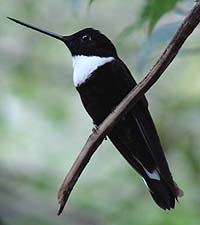 veritable jungle with its profusion of birdlife and extensive trails, offers the chance to see some of the 360 species of birds recorded here. Over 30 species of hummingbird can be seen in our few days here as well as a good selection of ‘Choco endemics’. The gardens of our lodge can easily produce 50 species in a morning, and by travelling a little further we can search for specialities such as White-capped Dipper, Lyre-tailed Nightjar, Golden-headed Quetzal, Masked Trogon, Toucan Barbet, Club-winged Manakin, Beautiful Jay, Ocellated Tapaculo, Choco Toucan, Plate-billed Mountain Toucan, Green-and-Black Fruiteater, Cinnamon Becard, Andean Solitaire, Slate-throated Whitestart, Chestnut-breasted Chlorophonia, Tanager Finch, numerous spectacular tanagers and a multitude of dazzling hummingbirds with names like Gorgeted Sunangel, Purple-bibbed Whitetip, Empress Brilliant, Booted Racket-Tail and Collared Inca, many of which can be observed easily around the lodge.
veritable jungle with its profusion of birdlife and extensive trails, offers the chance to see some of the 360 species of birds recorded here. Over 30 species of hummingbird can be seen in our few days here as well as a good selection of ‘Choco endemics’. The gardens of our lodge can easily produce 50 species in a morning, and by travelling a little further we can search for specialities such as White-capped Dipper, Lyre-tailed Nightjar, Golden-headed Quetzal, Masked Trogon, Toucan Barbet, Club-winged Manakin, Beautiful Jay, Ocellated Tapaculo, Choco Toucan, Plate-billed Mountain Toucan, Green-and-Black Fruiteater, Cinnamon Becard, Andean Solitaire, Slate-throated Whitestart, Chestnut-breasted Chlorophonia, Tanager Finch, numerous spectacular tanagers and a multitude of dazzling hummingbirds with names like Gorgeted Sunangel, Purple-bibbed Whitetip, Empress Brilliant, Booted Racket-Tail and Collared Inca, many of which can be observed easily around the lodge.
Our local guide knows where to find all the specialities of the region and we will visit Los Bancos and Pedro Vicente Maldonado where a whole host of other species can be found, including Moss-backed 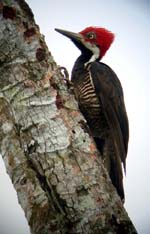 Tanager, Choco and Chestnut-mandibled Toucans, Pale-mandibled Aracari, Guayaquil Woodpecker, Pacific Hornero, Yellow-collared Chlorophonia and Choco Trogon. The many colourful tanagers present will include Flame-rumped, White-capped, Tawny-crested, Scarlet-browed, White-shouldered and Swallow Tanagers, and there are also Slate-colored Grosbeak, Red-headed Barbet, Ornate and Rusty-margined Flycatchers, Streak-headed Woodcreeper, Pacific Antwren, Cinnamon and One-colored Becards amongst many other possibilities. Possibly the highlight of our stay here will be a dawn visit to a lek of the spectacular Andean Cock-of-the-Rock. The males of this species are an incredible bright scarlet-red and to see up to 15 of these birds displaying in front of us must rank as one of the worlds greatest avian sights! A new and very exciting sideline to this is that the locals here now put out worms which attract several seldom seen forest dwellers, namely Giant, Yellow-breasted and Moustached Antpittas, and Dark-backed Wood-Quail. Few people have ever seen such difficult birds up close and just a few feet away! Bring your camera!
Tanager, Choco and Chestnut-mandibled Toucans, Pale-mandibled Aracari, Guayaquil Woodpecker, Pacific Hornero, Yellow-collared Chlorophonia and Choco Trogon. The many colourful tanagers present will include Flame-rumped, White-capped, Tawny-crested, Scarlet-browed, White-shouldered and Swallow Tanagers, and there are also Slate-colored Grosbeak, Red-headed Barbet, Ornate and Rusty-margined Flycatchers, Streak-headed Woodcreeper, Pacific Antwren, Cinnamon and One-colored Becards amongst many other possibilities. Possibly the highlight of our stay here will be a dawn visit to a lek of the spectacular Andean Cock-of-the-Rock. The males of this species are an incredible bright scarlet-red and to see up to 15 of these birds displaying in front of us must rank as one of the worlds greatest avian sights! A new and very exciting sideline to this is that the locals here now put out worms which attract several seldom seen forest dwellers, namely Giant, Yellow-breasted and Moustached Antpittas, and Dark-backed Wood-Quail. Few people have ever seen such difficult birds up close and just a few feet away! Bring your camera!
On Day 5 we return to our guide’s lodge for the night and have time to prepare for our exciting visit to the fabled Galápagos Islands tomorrow.
Day 6
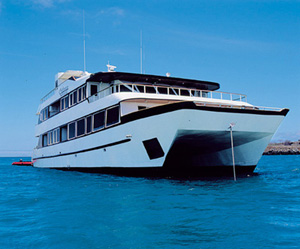 This morning we take a flight from Quito to the small island of Baltra in the Galápagos Islands, where we board our prestige “first class” motor yacht the “The Millennium” our home for the next 10 days and what has been described as probably the nicest yacht in the whole of Galápagos.
This morning we take a flight from Quito to the small island of Baltra in the Galápagos Islands, where we board our prestige “first class” motor yacht the “The Millennium” our home for the next 10 days and what has been described as probably the nicest yacht in the whole of Galápagos.
Life on the Millennium
The Millennium is an 82 foot motor catamaran, which began sailing the Galápagos Islands in 2002. This stable and luxurious ship spaciously accommodates 16 passengers in large double cabins (with two full size twin beds). All cabins have individual climate control, security boxes, private balconies and private bathrooms with hot water showers. The entire vessel is fully air-conditioned and features a large dining room, lounge and bar. All the social areas have a direct view to the ocean. The ship’s friendly crew will attend to us exclusively as we have the entire boat to ourselves. An international cook will keep us well fed and a bilingual, naturalist guide licensed by the Galápagos National Park Service will lead our explorations of the islands. Small motor boats will ferry us to and from the islands.
Click on the thumbnails to see larger views of the Millenium's lovely interior:
Once we are safely aboard our ship we will sail the short distance to North Seymour where we will follow a nature trail that takes us alongside a colony of Great and Magnificent Frigatebirds, and we can get our first experience of how extraordinarily confiding the birds are here. The trail takes us within a few yards of the frigatebirds with their huge red, inflated throat pouches, and will provide some of the most memorable sightings of the whole trip! As we walk around Blue-footed Boobies and Galápagos Sealions standing on the path, we need to keep an eye out for the scarce Land Iguana and rare Lava Gulls as well.
Days 6 - 14: Visiting the Islands
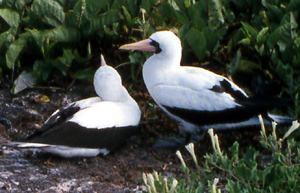 By evening, we'll have settled in to the Millennium’s comfortable cabins for our cruise of the islands and our guide will brief us on our itinerary. Each day we will visit one or more of the islands and we will often cruise at night, enabling us to make maximum use of daylight hours to explore the islands. As we move from island to island, we will watch for whales, dolphins, rays and other sea life that abounds in the waters around the Galápagos. To protect the wildlife and minimize the impact of tourism, access to the islands is tightly controlled and we will go ashore only with our GNPS guide. Don’t be surprised if we head out at first light to see wildlife when it is most active. Since most of our stops are in unspoiled wildlife areas, there may or may not be docks at our landing spots. Hence, small motor boats will take us to and from shore. Some landings will be wet and others will be dry. Each evening (and whenever appropriate), we will review the list of sightings of the day and be briefed on what to expect next.
By evening, we'll have settled in to the Millennium’s comfortable cabins for our cruise of the islands and our guide will brief us on our itinerary. Each day we will visit one or more of the islands and we will often cruise at night, enabling us to make maximum use of daylight hours to explore the islands. As we move from island to island, we will watch for whales, dolphins, rays and other sea life that abounds in the waters around the Galápagos. To protect the wildlife and minimize the impact of tourism, access to the islands is tightly controlled and we will go ashore only with our GNPS guide. Don’t be surprised if we head out at first light to see wildlife when it is most active. Since most of our stops are in unspoiled wildlife areas, there may or may not be docks at our landing spots. Hence, small motor boats will take us to and from shore. Some landings will be wet and others will be dry. Each evening (and whenever appropriate), we will review the list of sightings of the day and be briefed on what to expect next.
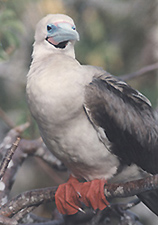 Cruising the Islands
Cruising the Islands
Our cruise will take us to the most important islands of the Galápagos archipelago. The itinerary will be flexible with the goal of seeing as much wildlife and as many endemics as possible. Though our itinerary is subject to change according to wildlife viewing opportunities and Galápagos National Park restrictions, we will visit some or all of the following islands:
Genovesa, also known as Tower Island, in the northern Galápagos just north of the equator. Darwin Bay, the protected harbor of this low-lying island, is the flooded crater of an extinct volcano. Young Red-footed Boobies will greet us in the bay and likely perch on the deck of our ship. All around the bay we’ll look for Great Frigatebirds with their huge red gular pouches, tiny Wedge-rumped (or Galápagos) Storm Petrels, Swallow-tailed Gulls, Lava Gulls, Brown Noddys, and elegant Red-billed Tropicbirds. This truly oceanic island is a nesting site for some of the most pelagic species in the Galápagos archipelago. Ashore, we will explore colonies of Red-footed and Nazca Boobies, try for closer looks at rare Lava Gulls and endemic Swallow-tailed Gulls, and watch for Short-eared Owls hunting Galápagos petrels coming from and going to their burrows. Inland, we will look for some of Darwin's famous finches including Large Ground Finch, Sharp-beaked Ground Finch, and Warbler Finch, as well as Galápagos Dove.
San Cristobal Island is the fifth biggest island of the Galápagos and was Darwin’s first landing spot in the islands. Puerto Baquerizo Moreno, the political capital of the Galápagos, is here. Comprising three or four extinct volcanoes, San Cristobal is the only place in the world where the Chatham Mockingbird can be found. We’ll look for Great and Magnificent Frigatebirds on this charming, peaceful island as well as endemic Lava Lizards on the ground. And, we’ll travel into the highlands to find Dark-billed Cuckoo, Vegetarian Finch, as well as some of the other finches.
 Wildlife-filled Española or Hood Island, is the southernmost island of the Galápagos. Here, we will visit two incredible sites - Gardner Bay and Punta Suárez. Galápagos Sea Lions will greet us at Gardner Bay. Ashore, we will meet the endemic Hood Mockingbird, known for its tendency to follow tourists, Yellow Warbler, American Oystercatcher, Wandering Tattler, and some of the thirteen species of Darwin’s finches including Large Cactus Finch and Warbler Finch. At Punta Suárez, we will walk a trail that leads through a Blue-footed Booby nesting colony and the only known nesting site of the enormous Waved Albatross. Along the way we will marvel at Marine Iguanas, watch Sally Lightfoot Crabs scurry over the lava, and keep an eye out for Galápagos Hawks perched on the low vegetation. The trail leads toward the cliffs where we will watch albatross and other seabirds soaring and see the famous blowhole, a fissure in the lava where water spurts high into the air like a geyser.
Wildlife-filled Española or Hood Island, is the southernmost island of the Galápagos. Here, we will visit two incredible sites - Gardner Bay and Punta Suárez. Galápagos Sea Lions will greet us at Gardner Bay. Ashore, we will meet the endemic Hood Mockingbird, known for its tendency to follow tourists, Yellow Warbler, American Oystercatcher, Wandering Tattler, and some of the thirteen species of Darwin’s finches including Large Cactus Finch and Warbler Finch. At Punta Suárez, we will walk a trail that leads through a Blue-footed Booby nesting colony and the only known nesting site of the enormous Waved Albatross. Along the way we will marvel at Marine Iguanas, watch Sally Lightfoot Crabs scurry over the lava, and keep an eye out for Galápagos Hawks perched on the low vegetation. The trail leads toward the cliffs where we will watch albatross and other seabirds soaring and see the famous blowhole, a fissure in the lava where water spurts high into the air like a geyser.
Floreana is one of the oldest islands of the Galápagos. Here we will visit the green olivine and white flour beaches of Punta Cormorán. We’ll scan the large lagoon on the island for Greater Flamingos, Whimbrel, Black-necked Stilt, Ruddy Turnstone, Brown Pelican, Magnificent and Great Frigatebird. The lowlands are also a good spot for seeing Large-Billed Flycatchers, Small-Ground Finches, Medium-Ground Finches, and Cactus Finches. We will visit the small town of Puerto Velasco Ibarra and take a trip to the highlands of Floreana to search for the endemic Medium Tree Finch. Also possible are Paint-billed Crake, Vermilion Flycatcher, Galápagos Flycatcher, and Smooth-billed Ani. We’ll also check Champion Islote just off Floreana for the rare Charles Mockingbird.
Isabela is the largest of the Galápagos islands and contains five active volcanoes, each with its own set of wildlife. 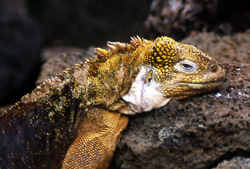 We’ll visit the western side of the island, home to Galápagos Penguin and Flightless Cormorant colonies. Punta Moreno on the southwestern shore of Isabela has spectacular views of the volcanoes. We’ll survey the rugged, barren landscape and its oases of small salty lakes for shorebirds, Greater Flamingos, White-cheeked Pintail, Striated Heron, Lava Heron, Yellow-crowned Night-Heron, Common Gallinule, Great-blue Heron, and Brown Pelican. We’ll also check the mangrove-lined lagoons for Green Sea Turtles and White-tipped Sharks. At Urbina Bay at the foot of Alcedo volcano, we will search for Galápagos Penguin, Flightless Cormorant, Magnificent Frigatebirds, Semi-terrestrial Hermit Crab, and Marine and Land Iguanas. And, we will look for very rare Mangrove Finch confined to a small mangrove forest only on the island of Isabela.
We’ll visit the western side of the island, home to Galápagos Penguin and Flightless Cormorant colonies. Punta Moreno on the southwestern shore of Isabela has spectacular views of the volcanoes. We’ll survey the rugged, barren landscape and its oases of small salty lakes for shorebirds, Greater Flamingos, White-cheeked Pintail, Striated Heron, Lava Heron, Yellow-crowned Night-Heron, Common Gallinule, Great-blue Heron, and Brown Pelican. We’ll also check the mangrove-lined lagoons for Green Sea Turtles and White-tipped Sharks. At Urbina Bay at the foot of Alcedo volcano, we will search for Galápagos Penguin, Flightless Cormorant, Magnificent Frigatebirds, Semi-terrestrial Hermit Crab, and Marine and Land Iguanas. And, we will look for very rare Mangrove Finch confined to a small mangrove forest only on the island of Isabela.
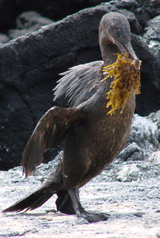
Fernandina, one of the largest unspoiled islands in the world, is also the youngest of the Galápagos islands. This is the most sparsely vegetated of the islands. Its landscape is dominated by stark lava fields, the result of volcanic eruptions in the last 20 years. Unique in every way, Fernandina is home to large congregations of Marine iguanas that sunbathe on the lava and spit salt that they ingest from drinking seawater. If the water is clear, we’ll snorkel near shore and look for Marine Iguanas feeding underwater. Fernandina is also the best place to see the Flightless Cormorant, a rare endemic that has lost its ability to fly and uses instead its powerful feet to swim and fish in the waters around the islands. We’ll look for Western Galápagos Racer, Lava Lizard, as well as Galápagos Sea Lions, Sally Lightfoot Crabs, rays, and sea turtles in the waters along the shore.
Also known as James and San Salvador, the island of Santiago is located in the middle of the Galápagos archipelago. Its spectacular shoreline features striated yellow, brown, and black cliffs of hardened volcanic ash eroded and polished by the ocean into elaborately patterned rocky beaches. Feeding frenzies of boobies or pelicans occur just offshore. As we walk the trail past the teeming tidal pools, we’ll look for Marine Iguanas, Galápagos Hawk, Lava Heron, and Galápagos Dove. At the end of the trail is a magnificent lava-walled grotto with a small population of rare Galápagos Fur Sea Lions.
The small rugged island of Bartolome has a variety of land formations including volcanic cones, lava tubes, mangrove forests, and white sand beaches. Consequently, 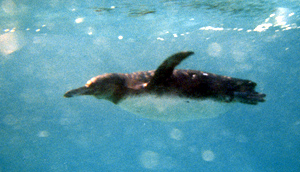 we will encounter a variety of wildlife here including Galápagos hawk, Galápagos Penguin, Sally Lightfoot Crab, Lava Heron, Marine Iguana, and Galápagos Sea Lion. Bartolome also has one of the best known and most photographed landmarks in the archipelago - Pinnacle Rock, a remnant volcanic cone. Those of us with the energy will hike to the top of Heartbreaker, the island’s 259-foot summit, for splendid panoramic views. The hike is a great way to see geology in action with two types of lava, spatter cones, cinder cones, and lava tubes all en route to the summit.
we will encounter a variety of wildlife here including Galápagos hawk, Galápagos Penguin, Sally Lightfoot Crab, Lava Heron, Marine Iguana, and Galápagos Sea Lion. Bartolome also has one of the best known and most photographed landmarks in the archipelago - Pinnacle Rock, a remnant volcanic cone. Those of us with the energy will hike to the top of Heartbreaker, the island’s 259-foot summit, for splendid panoramic views. The hike is a great way to see geology in action with two types of lava, spatter cones, cinder cones, and lava tubes all en route to the summit.
We’ll also explore the small islet of Seymour Norte, famous for its seabird colonies. The Blue-footed Booby colonies on North Seymour are the best place to photograph the dancing, sky pointing and other courtship activities.
We'll also have a two night stay in Puerto Ayora on the island of Santa Cruz in the central Galápagos. Puerto Ayora is the largest town in the archipelago and will serve as our land base as we explore Santa 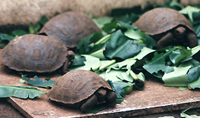 Cruz and its wildlife. We will have two days to experience life on this unique island which rises to almost 3,000 feet above sea level and offers visible, dramatic changes in its flora and fauna from one area to another. We’ll visit the Charles Darwin Research Station, a haven of scientific inquiry and famous for its successful Giant Tortoise breeding program. And, we’ll travel into the Santa Cruz highlands to see the varied habitats, explore lava tubes, sinkholes, and volcanic craters and search for highland species. We’ll keep an eye out for Vermillion Flycatcher, Galápagos Rail, Large-billed Flycatcher, Small Tree Finch, Large Tree Finch, Woodpecker Finch, and Vegetarian Finch. With a little luck, we’ll find Giant Tortoises in the wild.
Cruz and its wildlife. We will have two days to experience life on this unique island which rises to almost 3,000 feet above sea level and offers visible, dramatic changes in its flora and fauna from one area to another. We’ll visit the Charles Darwin Research Station, a haven of scientific inquiry and famous for its successful Giant Tortoise breeding program. And, we’ll travel into the Santa Cruz highlands to see the varied habitats, explore lava tubes, sinkholes, and volcanic craters and search for highland species. We’ll keep an eye out for Vermillion Flycatcher, Galápagos Rail, Large-billed Flycatcher, Small Tree Finch, Large Tree Finch, Woodpecker Finch, and Vegetarian Finch. With a little luck, we’ll find Giant Tortoises in the wild.
Day 15
This morning we transfer to Baltra this morning for our flight back to Quito. On arrival, we will be met by our coach and spend the evening relaxing at our guide's private lodge.
Day 16
This morning we will visit the nearby and spectacular reserve of Antisana. Set high above the city of Quito, it is seemingly a world away and a picture of remoteness. Here we have a good chance to find the mighty Andean Condor, as well as Black-chested Buzzard-Eagle, and numerous Carunculated Caracaras. At the top beside a mountain lake we could find Black-faced Ibis, Andean Gull, Andean Duck, Andean Coot, Andean Lapwing, Silvery Grebe and possibly Aplomado Falcon. While roadside stops could produce Black-winged Ground-Dove, Grass Wren, Paramo Pipit, Giant Hummingbird, Shining Sunbeam, Black-tailed Trainbearer and Black-billed Shrike-Tyrant. We will return from this very different habitat back to Quito in time for an evening flight back home.
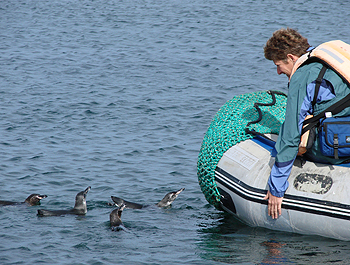 Galápagos & Ecuador Galápagos & Ecuador September 25 - October 9, 2008 TOUR PRICE: $ 5,195.00 per person from Quito, Ecuador based on double occupancy. Deposit: $500 per person for standard double cabin, $700 per person for the suite (limited availability) Maximum Group Size: 14 plus leaders. Included in cost:
Not included:
Cancellations and Refunds: Refunds, less a cancellation fee of $200 per person will be made only if Sunrise Birding, LLC is notified in writing of intent to cancel on or before May 25, 2008. No refunds will be made after May 25, 2008. All cancellations must be made in writing. There are no refunds for unused meals, accommodations, or other trip features. Insurance: The purchase of trip cancellation insurance is strongly recommended. Sunrise Birding, LLC can not accept liability for airline cancellations or delays or penalties incurred by the purchase of non-refundable airline tickets or other expenses incurred by tour participants in preparing for this tour. Questions? Contact Gina Nichol at gina@sunrisebirding.com Phone: 203.453.6724 |
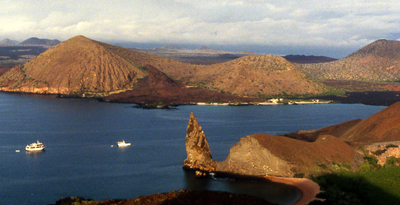
All photos copyright Gina Nichol.



